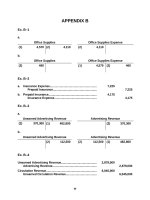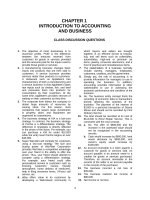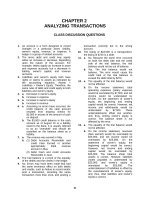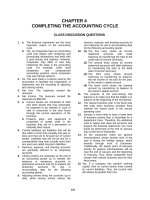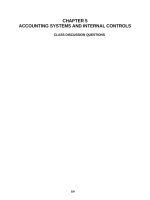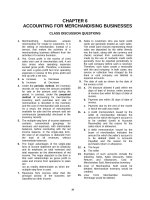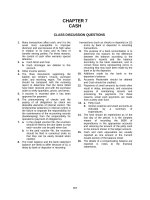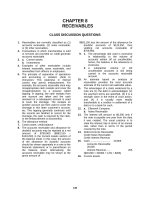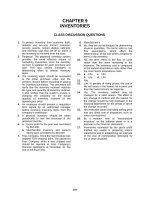Solution manual investments 10th by jones ch18
Bạn đang xem bản rút gọn của tài liệu. Xem và tải ngay bản đầy đủ của tài liệu tại đây (153.12 KB, 15 trang )
Chapter 18:
Futures
CHAPTER OVERVIEW
Chapter 18 is designed to cover the basics of futures
markets in general but with primary emphasis on financial
futures. While the basics are applicable to any commodity,
and money can be thought of as another commodity, it is felt
that students will receive the most benefit from
concentrating on financial futures after a general
introduction to the subject, which is one of the more
difficult subjects for beginners.
The first part of the chapter develops the idea of a
forward market and a futures market, outlines current U. S.
futures markets, and describes the structure of futures
markets. This provides the student with the necessary
background information.
The chapter next focuses on the mechanics of trading,
including all of the basics. Margin, which is completely
different from that involving stocks, is developed in
detail, including an example.
The chapter discusses the use of futures contracts by
explaining the role of hedgers and speculators. This
includes a description of basis. The subsequent discussion
is organized by examining how to both hedge and speculate in
both interest rate futures and stock index futures. The
necessary background information is provided, along with
examples of how to use the contracts, with particular
emphasis on short hedges. The limitations of hedging are
considered. Speculating with both interest-rate futures and
stock-index futures is discussed.
The chapter concludes with a discussion of program
trading, which is often cited in the popular press.
5
CHAPTER OBJECTIVES
To explain the basics of futures markets in general.
To explain financial futures in particular--what is
available, how they are used, what they can accomplish.
To illustrate various hedging and speculating
strategies using both interest rate options and stock
index options.
MAJOR CHAPTER HEADINGS [Contents]
Understanding Futures Markets
Why Futures Markets?
[reasons for forward markets and futures markets]
Current U. S. Futures Markets
[futures markets as classified in The Wall Street
Journal]
Foreign Futures Markets
[brief description of futures markets in other
countries]
Futures Contracts
[basic characteristics]
The Structure Of Futures Markets
Futures Exchanges
[members of the exchanges]
The Clearinghouse
[the role of the clearinghouse]
6
The Mechanics of Trading
Basic Procedures
[short position vs. long position; offset; price
fluctuations; commissions]
Margin
[good faith deposit; margin call; how accounts are
marked to the market, including example]
Using Futures Contracts
[traditional uses]
Hedgers
[trying to offset the risk in a cash position]
How to Hedge With Futures
[basic idea; short hedge; long hedge]
Speculators
[trying to profit by their actions]
Financial Futures
[reasons for; differences between these and commodity
futures]
Interest Rate Futures
[what contracts are available; reading quotes; hedging
and speculating with interest rate futures, with
examples]
Stock-Index Futures
[how they work; hedging with stock-index futures; how
short hedges work; example; long hedges; limitations of
hedging with stock index futures; index arbitrage and
program trading; speculating with stock index futures-benefits; strategies--spreaders (intramarket and
intermarket]
7
Appendix 18-A
Futures Options
POINTS TO NOTE ABOUT CHAPTER 18
Tables and Figures
Exhibit 18-1, showing the types of futures contracts
available, is for general reader interest.
Table 18-1, showing how investor accounts involving
futures are marked to the market, is worth emphasizing
because it helps to explain the real risk of futures
contracts--the equity can be wiped out, or diminished
severely, very quickly.
Exhibit 18-2 on characteristics of interest rate
futures contracts can be examined by students on their own.
Exhibit 18-3 on hypothetical quotes on bond futures
contracts also provides basic information.
Exhibit 18-4 illustrates a short hedge for interest
rate futures. The major emphasis should be on the short
hedge since most investors are long the cash position and
must hedge by selling futures.
Table 18-2 illustrates both short and long hedges using
stock-index futures. Although designed to be simple
examples, they convey the essence of the hedge involved, and
students can readily understand them.
Figure 18-1 shows return distributions for hedged and
unhedged positions on a conceptual basis. The idea, of
course, is to show why investors might choose to hedge their
positions.
Figures 18-2 through 18-4 are worthwhile as
transparencies to reinforce the points illustrated and
provide the basis for classroom discussion.
•
Figure 18-2 shows that the value of a well-diversified
stock portfolio tracks very closely the price of the
S&P 500 index futures.
8
•
Figure 18-3 shows the value of a well-diversified
portfolio versus the value of the same portfolio hedged
by sales of S&P 500 index futures--the hedged portfolio
is much less volatile than the unhedged portfolio.
•
Figure 18-4 (a) compares the value of a relatively
undiversified portfolio with the price of the S&P 500
futures contract. This portfolio is only 66 percent
diversified, and the futures contract does not move all
that closely with the portfolio.
Figure 18-4 (b) shows that a hedged position in this
situation is only 27 percent lower than an unhedged
position. Thus, stock-index futures generally do not
provide a good hedge for relatively undiversified
portfolios.
NOTES ABOUT APPENDIX 18-A
This appendix, which covers futures options, can easily
be omitted without any loss of continuity. It is provided
for the sake of completeness for those who want to cover
this topic. Because of time constraints and because of the
difficulty of the subject, many instructors choose to skip
this topic. Perhaps the best approach is to simply
acknowledge the existence of these instruments but not spend
time discussing them.
9
ANSWERS TO END-OF-CHAPTER QUESTIONS
18-1.
A futures contract is a commitment to buy or sell at
a specified future settlement date a designated
amount of some item. A firm agreement by two
parties, the seller of the futures contract agrees
to make delivery, and the buyer agrees to take
delivery, at a currently determined market price.
18-2.
All futures contracts are marked to the market
daily; that is, all profits and losses on a contract
are credited and debited to each investor's account
every trading day.
Almost all (95%+) futures contracts are settled by
offset rather than delivery; that is, holders
liquidate a position by arranging an offsetting
transaction.
18-3.
The clearinghouse ensures the fulfillment of each
futures contract. Buyers and sellers settle with
the clearinghouse, not with each other. The
clearinghouse is on the other side of all
transactions, and stands ready to fulfill a contract
if either buyer or seller defaults. Thus, the
clearinghouse helps to facilitate an orderly market
in futures.
18-4.
The initial margin deposited with a broker is the
equity of the transactor. Each contract also
requires a maintenance margin below which the
investor’s equity cannot drop. If the equity
declines below the maintenance margin, a margin call
occurs. It should be remembered that all contracts
are marked to the market daily; that is, all profits
and losses are debited and credited daily to an
investor’s account.
18-5.
Differences between trading in stocks and trading in
futures contracts include:
(a)
The whole concept of margin is different
because no credit is being extended with
futures contracts.
10
18-6.
(b)
Margin is the norm in futures but not in stock
trading.
(c)
Most futures contracts have a daily price limit
while stocks do not.
(d)
Unlike stocks, there are no price movement
restrictions with short sales.
(e)
Futures positions have definite termination
dates.
(f)
Brokerage commissions for futures are paid on
the basis of a completed contract, unlike
stocks.
(g)
There are no specialists on futures exchanges.
(h)
Futures contracts are not securities.
Financial futures differ from other futures
contracts in a few respects.
With stock index futures, the seller settles in cash
at maturity--there is no delivery. Also, unlike
traditional futures contracts, stock index futures
typically have no daily price limits.
18-7.
Hedgers buy or sell futures contracts in order to
offset the risk in some other position. They want
to reduce the risk of adverse price fluctuations.
Hedgers forego some potential profits to eliminate
part of the risk.
Speculators buy or sell futures contracts in an
attempt to earn a return. They are willing to
assume the risk of price fluctuations, hoping to
profit from them.
18-8.
Basis can be, and is, defined in different ways. In
this edition basis is defined as the difference
between the cash price of an item and the futures
price of the contract used, and the basis is
positive when this difference is positive.
11
18-9.
Price quotations on Treasury bonds are percentages
of par, are quoted in 32nds, and the face value is
$100,000. Therefore, a price of:
80-5 is 80 5/32 of $100,000 or $80,156.25
90-24 is 90 24/32 of $100,000 or $90,750.00
69-2 is 69 2/32 of $100,000 or $69,062.50.
18-10.
A manager with a bond position may plan to sell the
bonds later but meanwhile fears a rise in interest
rates. To protect the portfolio, a short hedge can
be used. If interest rates rise (and, therefore,
bond prices drop), the manager will gain on the
short hedge while losing on the cash position (i.e.,
the portfolio).
18-11.
Risk cannot be entirely eliminated in a hedge
because of basis risk. The basis fluctuates in an
unpredictable manner, and changes in the basis will
affect the hedge position during its life.
18-12.
A weighted short hedge adjusts for the differences
between the 8% coupon assumed in the Treasury bond
futures contract and the coupon bonds actually being
held in the portfolio. Higher coupon bonds will
cause a greater decline in dollar value relative to
the futures contract. A conversion factor is
available to adjust hedge amounts.
A straight short hedge, on the other hand, would
simply match the dollar value of the portfolio with
the number of $100,000 contracts that would be
comparable.
18-13.
Investors could have preferences among the different
stock index futures as a result of the composition
of their particular portfolios. The New York Stock
Exchange Index, covering only NYSE stocks, is not
the same as the Value Line Index, which covers NYSE,
AMEX, and OTC stocks.
12
18-14.
Stock index futures allow investors to hedge
systematic (market) risk. This is desirable for
investors attempting to earn the unique part of a
stock's return while avoiding market risk. The
futures contract helps to protect the portfolio
against market fluctuations.
18-15.
A pension fund could use a long hedge with stock
index futures if a market rally was expected but the
fund was not ready with individual stock selections.
Buying futures contracts would provide gains if the
market does rise, and would help to offset the cost
of buying stocks at the higher prices existing after
the rise.
18-16.
•
An investor would likely buy a call on a stock
index if he or she expected a rise in the
market and wanted to try to take advantage of
this expectation.
•
An investor would likely buy puts on interest
rate futures if he or she expected interest
rates to rise (which would cause a decline in
bond prices).
18-17.
Program trading involves the use of computergenerated orders to buy and sell securities based on
arbitrage opportunities. The arbitrage occurs
between common stocks, on the one hand, and index
futures and options, on the other.
Large institutional investors seek to exploit
differences between the two sides. Specifically,
when stock index futures prices rise substantially
above the current value of the stock index itself
(e.g., the S&P 500), they sell the futures and buy
the underlying stocks, typically in “baskets” of
several million dollars.
Because the futures price and the stock index value
must be equal when the futures contract expires,
these investors are seeking to “capture the premium”
between the two, thereby earning an arbitrage
profit. That is, they seek high risk-free returns
by arbitraging the difference between the cash value
of the underlying securities and the prices of the
futures contracts on these securities. In effect,
13
they have a hedged position and should profit
regardless.
CFA
18-18.
Call options give the owner the right, but not the
obligation, to purchase SFr’s for a pre-specified
amount of domestic currency. Purchasing an at-themoney call option would guarantee the current
exchange rate over the life of the option. If the
SFr declines in value, the call will not be
exercised since francs can be purchased more cheaply
in the open market and redeeming the bond issue will
be less costly.
Contrasting characteristics:
•
•
•
•
•
•
•
Currency options are traded world-wide and
enjoy a liquid market.
Exchange-traded currency option contracts have
standard amounts, maturities, etc.
Over-the-counter options could be tailored to
meet Michelle's needs.
The initial cash outflow would be the premium.
The use of options preserves the ability to
profit.
No counterparty credit risk.
Must roll to match 5-year obligation.
Currency forward contracts commit the seller to
deliver the specified amount of currency to the
buyer on a specified future date at a fixed price.
A short position in a forward contract requires
delivery.
Contrasting characteristics:
•
•
•
•
•
The market for forward contracts is over-thecounter and sometimes may not be as liquid as
option or futures market.
Forward contracts may be custom-designed for
specific applications.
Cash does not change hands until a forward
contract is settled.
Counterparty credit risk.
Can best match 5-year obligation.
14
Currency futures are like forward contracts except
the gain or loss is settled daily under the
supervision of an organized exchange. A short
position in the futures requires either offset or
delivery at expiration.
Contrasting characteristics:
•
•
•
•
•
•
CFA
18-19.
d
CFA
18-20.
d
CFA
18-21.
b
CFA
18-22.
c
CFA
18-23.
b
CFA
18-24.
b
Futures are traded in standardized contracts
and are highly liquid.
Cash is required for daily settlement.
A margin account is required.
Management and administration costs are higher
than with a forward or option contract.
No counterparty credit risk.
Must roll to match 5-year obligation.
15
ANSWERS TO END-OF-CHAPTER PROBLEMS
18-1.
(a)
The initial margin is $3500. Each point in
price is equivalent to 20 ticks worth $25 each,
or $500.
Equity on day of purchase
= $3500--the initial
position
Equity 1 day after purchase
= $3650 [67.8 - 67.5 = .3
or 6 ticks worth $150]
Equity 2 days after purchase = $3800 [68.1 - 67.8 = .3
or 6 ticks worth $150]
Equity 3 days after purchase = $3750 [68 - 68.1 = -.1
or 2 ticks worth -$50]
Equity 4 days after purchase = $4000 [68.5 - 68
= .5
or 10 ticks worth $250]
18-2.
(b)
The excess equity for these four days is +150,
+300, +250, and +500.
(c)
The final gain is one point, or $500.
(d)
An investor who was short over this same period
would show the same numbers in reverse; that
is, equity shortages and a final loss of $500.
The aggregate change in market value is the
difference between the current price (or closing
price) and the initial price multiplied by $500.
Therefore
[70.5 - 67.5] X $500 = $1500
18-3.
(a)
Sell 10 contracts at 82-20 each
82-20 = $82,625 and 10 contracts = $826,250
Buy 10 contracts at 76-12 each
76-12 = $76,375 and 10 contracts = $763,750
This is a short position and the price
declined. The total profit is $826,750 $763,750 = $63,000.
16
(b)
Sell 10 contracts at 80-14 each
80-14 = $80,437.50 and 10 contracts = $804,375
Buy 10 contracts at 77 each
77 = $77,000 and 10 contracts = $770,000
This is a short position, and the price
declined. The total profit is $804,375 $770,000 = $34,375.
(c)
Buy 15 contracts at 62-10
62-10 = $62,312.50 and 15 contracts =
$934,687.50
Sell 15 contracts at 64-24
64-24 = $64,750 and 15 contracts = $971,250
This is a long position, and the price rose.
The total profit is $975,250 - $934,687.50 =
$40,562.50.
(d)
Sell one contract at 70-14
70-14 = $70,437.50
Buy one contract at 78-08
78-08 = $78,250
This is a short position; however, the price
rose. The total loss is $78,250 - $70,437.50 =
$7812.50.
18-4.
(a)
The manager is long in the cash market, so to
protect this position the manager would
establish a short position. At $100,000 per
contract, the manager should sell 10 futures
contracts with a maturity three months hence
(we are ignoring weighted hedges).
(b)
The manager sells 10 contracts at a current
price of 68, for a total transaction value of
$680,000. The manager repurchases 10 of these
contracts three months later at a price of 5912, for a total transaction value of $593,750
($59,375 x 10). Therefore, this was a
successful hedge with a total dollar gain of
$86,250.
The futures position gains $86,250.
17
(c)
If the bonds are priced at 67-8 three months
later, the cash market position is:
beginning -- $76,062.50 X 10 = $760,625
ending
-- $67,250
X 10 = 672,500
loss
$ 88,125
The portfolio (cash) position declines $88,125.
(d)
CFA
18-5.
The net effect of this hedge is a loss of
$88,125 - $86,250 = $1875
Information about foreign firms is often difficult
to obtain on a timely basis and, once obtained, can
be difficult to interpret and analyze due to
language and presentation differences.
Financial statements are not comparable from country
to country. Different countries use different
accounting principles. Even when similar accounting
methods are used, cultural, institutional, political
and tax differences can make cross-country
comparisons hazardous and misleading.
Stock valuation techniques useful in the U.S. may be
less useful in other countries. Stock markets in
different countries value different attributes.
Smith must consider currency risk in selecting nonU.S. stocks for his portfolio.
Increased costs: custody, management fees, and
transactions expenses are usually higher outside the
U.S.
The candidate must realize that a futures contract
is a commitment to transact in the future. The
price of the contract on any given day is a function
of the current price of the underlying commodity
(index price) plus the time value of money less, in
this case, any dividends received.
F0 = S0(1 + rj - d)m
Where:
F0 = Futures Contract Price
18
S0
rj
d
m
=
=
=
=
Index Price = 15,000
Risk Free Rate = .05
Dividend Yield = .02
Length of Contract (years) = .5
Therefore:
F0 = 15,000(1 + .05 - .02)0.5
F0 = 15,223
ANSWERS TO APPENDIX 18-A
18A-1.
(a)
(b)
(c)
(d)
greater than
greater than
less than
less than
19
